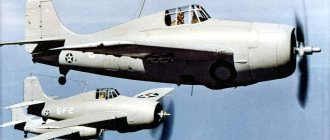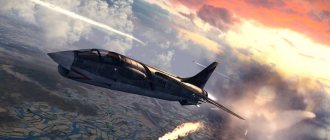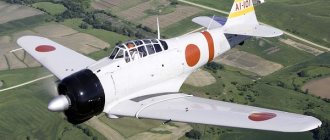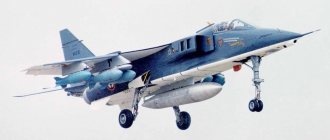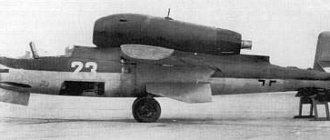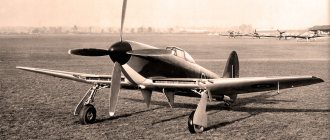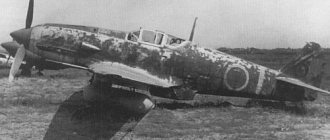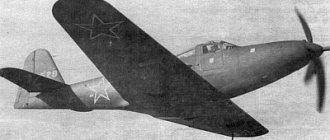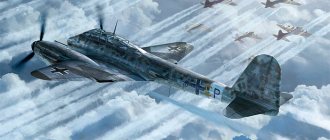Grumman F6F Hellcat, part 2
We continue to get acquainted with the history of the creation of the famous American naval fighter Grumman F6F Hellcat.
Modification F6F-5
At the end of January 1944, one specially trained F6F-3 fighter, which has improved tactical and technical characteristics, reached a speed of 660 km/h at an altitude of 6405 m on a horizontal section. Based on this vehicle and taking into account the experience gained during the production of all previous versions of the F6F-3, the F6F-5 modification was developed. The first production F6F-5 took off on April 4, 1944. Externally, the new vehicle was practically no different from its predecessor. The main changes were to increase the strength of the rear fuselage in order to prevent its deformation in the stabilizer area, which was inherent in the F6F-3, reinforced armor (up to 110 kg), as well as the installation of underwing bomb racks and “zero launch” missile guides (the weight of the suspended weapons increased up to 1542 kg). The aerodynamics of the airframe have become more advanced. The engine hood has changed slightly. The canopy of the pilot's canopy was modified: three armored glass panels were installed instead of one central one. Most cars (except for the first series of F6F-5) did not have transparent rear-view “ears” behind the pilot’s seat. The instrument panels had red backlighting. All vehicles were “standard” equipped with an underwing radar suspension unit. Some of the aircraft were armed with two 20-mm cannons with 250 rounds of ammunition per barrel and four 12.7-mm machine guns with 400 rounds of ammunition per barrel. However, the standard weapon remained with six 12.7 mm machine guns. In essence, the F6F-5 has become a multi-role fighter capable of operating day and night, and in different weather conditions.
The F6F-5 was equipped with a Pratt-Whitney R-2800-10W engine with a direct injection system for a water-methanol mixture into the cylinders. Tests showed that, in comparison with the F6F-3, the horizontal flight speed increased by 28 km/h, although the rate of climb remained at the same level. Thanks to the presence of trim tabs and adjustable bendable plates on both ailerons (the position of the plate on the left aileron was adjusted from the pilot's cabin), the roll rate increased, which improved the maneuverability of the aircraft. In conditions of mass production and the presence of low-skilled personnel, it can be difficult to achieve high symmetry in the design of the device, which entails specific, individual behavior in the air of each aircraft, which the pilot has to constantly counter with the controls. Adjustable plates were installed on controlled planes and served to balance the behavior of the aircraft in flight.
We have already noted that the production of aircraft was organized extremely efficiently, which made it possible already in November 1943 to increase the production of Hellcats to 400 aircraft per month. The concern for personnel on the part of the company's management was unprecedented. Free medical care, nurseries and after-school care for children, a friendly atmosphere, good salaries - all this contributed to the fact that staff turnover did not exceed 1%. At the end of 1944, the productivity of the company's factories reached 700 F6F aircraft per month. The naval aviation command was forced to ask to reduce the production of aircraft to 600 per month, since flight schools could not provide the required number of pilots. During the production process, the cost of one aircraft decreased from $50,000 to $35,000 (the price of the Corsair was 30% higher).
Production of the F6F-5 ended in November 1945. A total of 7,870 F6F-5, F6F-5N, F6F-5E and F6F-5P units were produced. The end of production of the F6F-5 simultaneously meant the end of the overall production of Hellcat fighters.
F6F-5N
Night fighter version of the F6F-5, equipped with the Sperry AN/APS-6 radar. The radar antenna was located in the gondola under the right console. The armament of most vehicles of this version consisted of two 20-mm Colt-Browning M2 cannons and four 12.7-mm Colt-Browning M2 machine guns. At least two aircraft of this version were converted to install a searchlight under the left wing console, used to detect and identify submarines on the surface. A total of 1,529 vehicles were produced.
F6F-5E
Modification of a night fighter with a Westinghouse AN/APS-4 radar. The composition of the equipment is identical to the F6F-3E.
F6F-5P
The reconnaissance version was equipped with a long-focus camera installed in the lower part of the fuselage behind the cockpit. The camera was intended for high-altitude reconnaissance. Some aircraft of this modification did not carry weapons.
Special modifications.
A small part of the production F6F-3 and F6F-5 fighters was converted into flying targets under the designation F6F-3K and F6F-5K. These aircraft could be remotely controlled both from ground and ship control stations, and from on board another aircraft. Some of these vehicles carried additional fuel tanks located at the wingtips. In 1946, some F6F-3K aircraft were used in research during nuclear explosions at Bikini Atoll. In 1952, during combat operations in Korea, unmanned F6F-5Ks, armed with a 908 kg bomb and television cameras in underwing containers, were used to destroy large targets. In 1949-58. a small number of specially modified aircraft were used for research into remote control of the F6F-5K fighter.
Combat use.
On January 16, 1943, the first few F6F-3 production vehicles were sent to the VF-9 day fighter squadron, then based on the escort carrier USS Long Island, for military and operational testing. Intensive flights with elements of combat use did not reveal any significant problems for the Hellcats (however, one of the pilots had to emergency land the vehicle on the forest due to engine failure, as a result of which it was completely destroyed, but the pilot was not injured). It turned out that the large wing area and heavy weight of the aircraft contribute to high stability in the behavior of the machine during landing mode, as a result of which the landing speed was even 8 km/h less than that of the Wildcat. By March 13, 1943, VF-9 was completely re-equipped with Hellcats and transferred to the aircraft carrier Essex for the purpose of familiarization and retraining of combatant pilots for the new fighter.
In mid-1943, the 9th Carrier Group, consisting of the attack aircraft carriers Essex and Yorktown, and the light aircraft carrier Independence, whose pilots were the first to master the F6F-3 and had 50 hours of flight time, was sent to the Marcus Island area , located 700 miles southeast of Japan, to support the upcoming amphibious operation. In the early morning of August 31, 1943, a large group of aircraft took off from aircraft carriers and headed for Marcus Island. The target for the attack was a Japanese airfield, which posed a real threat to the landing operation. Hellcat fighters from VF-5 (Yorktown) and VF-9 (Essex) were assigned to escort the bombers and attack aircraft. Even while approaching the island, they fired at several Japanese patrol ships - these were the first real F6F strikes on the enemy. The airfield on the island was well protected by anti-aircraft guns, so the Hellcats were deployed to suppress them, especially since the Japanese did not have time to scramble their fighters. In the most difficult conditions, Japanese anti-aircraft gunners showed their best side and shot down several American aircraft, including two Hellcats from VF-5. The pilot of one of them managed to reach his cruiser and splash down next to it. The sailors quickly lifted the pilot on board.
The next day, during the American invasion of Baker Island, F6F-3 pilots from the flight crew of the light aircraft carrier Bellew Wood and the light aircraft carrier Princeton announced the destruction of three Kawanishi N8K Emily heavy four-engine flying boats, which became the first aerial victories. won on Hellcats.
Everyone was looking forward to meeting the legendary Japanese carrier-based fighter Zero. On October 5, 1943, the Americans landed on Wake Island. This operation was covered from the air by fighters from the attack aircraft carriers Essex, Yorktown, Lexington and Cowpens. Before departure, the commander of the aviation group promised to give the first pilot to shoot down a Japanese plane a bottle of five-star Old Crow whiskey.
When the target was 50 miles away, the Japanese spotted a group of 47 Hellcats on radar and scrambled 27 of their Zeros. The first to discover the Japanese was the young pilot Robert Duncan from the aircraft carrier Yorktown and immediately attacked the nearest Zero, concentrating fire on its cockpit. The enemy plane flared up, brightly illuminating the still gloomy morning sky, and went down. Wasting no time, Dunncan quickly fell behind the next Japanese and fired a long burst - he began to smoke heavily, fell onto the wing and fell almost vertically into the water. Returning to his aircraft carrier, Dunncan was deservedly rewarded with a bottle of Old Crow.
At the beginning of November 1943, an air offensive of large American aircraft carrier forces began against the most important Japanese naval base of Rabaul. On November 5, 52 Hellcats provided cover for bombers and torpedo bombers in an attack on this port. About 70 Japanese fighters were scrambled to intercept the Americans. While the dive bombers and torpedo bombers circled over the island to attack, the Hellcats formed a dense protective curtain. In the fierce air battle, 25 Japanese (and presumably 25 other aircraft) were shot down. American losses amounted to 10 aircraft (two fighters and eight bombers), most of them shot down by anti-aircraft artillery.
On November 11, a repeated air attack on Rabaul was carried out. In response, the Japanese sent 120 aircraft (of which 67 fighters) against the formation of American aircraft carriers, which were met by Hellcats while approaching the aircraft carriers. During the air battle, 30 Japanese aircraft were shot down; American losses amounted to 11 fighters. This outcome of the battle clearly illustrated the superiority of the new American fighters and the increased level of training of American pilots.
The Hellcat pilots scored major victories during attacks on the Japanese fleet based on Kwajelein and a raid on the airfield located on Roi Island. The total number of enemy aircraft shot down was 91 aircraft. On December 4, in air battles, the Americans shot down 28 of 50 enemy aircraft, losing only two of their own.
The appearance of the Hellcats came as a complete surprise to the Japanese. It happened that young Japanese pilots disengaged from battle or simply left their cars when they saw the characteristic silhouette of an American fighter on the horizon.
By the end of 1943, the Hellcat had become the main fighter aircraft of the US Navy, based on all types of aircraft carriers operating in the Pacific Ocean. At this time, the Battle of the Gilbert Islands broke out, during which Hellcats shot down about 100 enemy aircraft. In total, in 1943 (over the course of five months), Hellcat pilots destroyed 230 Japanese aircraft, losing 30 of their own aircraft.
The Hellcat received high praise from Japanese pilots. “During the fighting in the Gilbert Islands in September 1943, the Grumman F6F Hellcat fighters made their debut. This carrier-based fighter became one of the Zero's most formidable opponents. The first reports of Grumman's new fighters indicated that his design was influenced by careful study by the Americans of the Zero captured in the Aleutian Islands. To some extent, the Americans even adopted the practice of saving weight, although this was completely atypical for American aircraft.
There is no doubt that the new Hellcat was superior to the Zero in almost every aspect except maneuverability and range. It gained altitude faster and dived faster, could fly at higher altitudes, and had protected tanks and armor. Like the Wildcat and Corsair, the new Hellcat was armed with six 12.7 mm machine guns. However, it carried much more ammunition than other fighters.
Of all the fighters in the Pacific theater of operations, only the Hellcat could hold its own in a fighter fight. The Americans stated that with the advent of the Hellcat, the American fleet had regained the ability to conduct close combat with the Zero. The Americans' favorite maneuver was the flat dive of a pair of fighters at high speed. If the Zero came within range of enemy machine guns, the Hellcats would open fire, rush past and make a U-turn.” In battles with maneuverable Zeros, Hellcat pilots, using high horizontal speed and powerful weapons, were able to destroy the enemy without allowing themselves to be drawn into the dangerous “carousel” of a protracted air battle.
The baptism of fire for the F6F-3N night fighters occurred in February 1944, when an aircraft from VF(N)-76 of the aircraft carrier Yorktown intercepted the B5N Kate bomber performing a night attack on the aircraft carrier Interpid.
In February 1944, the Americans launched an attack with aircraft carriers on the well-fortified fortress of Truk, which was sometimes called the Gibraltar of the Pacific. During the two-day raid, 129 enemy aircraft were destroyed in the air, 82 on the ground and 70 were damaged. Hellcats demonstrated high combat qualities and exceptional ease of piloting. In many ways, the Hellcat's legendary reputation was based on the high reliability of the engine and main components, as well as its good takeoff and landing characteristics. One day, the fighters of the aircraft carrier Cowpens were returning from a combat mission to cover a group of ships in complete darkness. Despite the fact that none of the pilots had experience in night landings on an aircraft carrier, all the planes landed safely on the Cowpens.
At dawn on March 30, 1944, the Americans launched a crushing attack on the Palau Islands. Fierce fighting broke out in the air. The enemy lost about 150 aircraft. US combat losses amounted to 25 aircraft. The Hellcat pilots had a convincing advantage in both tactics and individual skill.
One of the most famous American pilots to fly the Hellcat was David McCampbell. He was born January 16, 1910 in Bessemer, Alabama. As a young man, he was not accepted into the Stanton Military School: army doctors discovered “vision problems” in the future best fighter pilot of the US Navy. David repeated his attempt to become a pilot in June 1936. By this time, McCampbell had done a lot: graduated from a technological school, a naval school, worked in a construction company, at an aviation branch, served in the navy in carrier-based aviation as a gunner-observer with the rank of junior Lieutenant
And again the medical commission rejected his candidacy. McCampbell did not give up this time either. He consulted a civilian doctor, who declared his vision sufficient for aviation service. Finally, on the third attempt, the stubborn “Yankee” was accepted and transferred to Pensacoli Air Force Base in Florida, where he studied flying. On April 23, 1938, he was awarded the rank of naval pilot.
David's new destination was the aircraft carrier USS Ranger, where his squadron VF-4 was based. After two years of service, he was transferred to the aircraft carrier Wasp, but not as a pilot, but as a deck landing officer. After the sinking of the ship in the Coral Sea, McCampbell served at the Naval Air Station in Jacksonville, and later at the Melbourne base in Florida.
In September 1943, Lieutenant Commander David McCampbell was appointed commander of VF-15, based on the aircraft carrier Essex, and later commander of the carrier air group CAG 15. In the spring of 1944, Commander McCampbell began to fight again, now already a pilot. By that time, David had 2,000 hours of flight time, 600 of which were in the F6F-3 Hellcat fighter.
On June 11, 1944, he scored his first victory, shooting down an A6M2 Zero fighter over the island of Saipan, and after another 12 days he already had 11.5 downed aircraft. The day of June 19 was especially successful, when the pilot shot down six bombers in the first half of the day, and in the second he “added” two more Zero fighters. At the end of the summer, the US carrier fleet was aimed at liberating the Philippines. Carrier-based aviation received new F6F-5 fighters. These new aircraft also arrived in the VF-15 unit. On the morning of October 24, 1944, a large group of Japanese aircraft - 20 bombers, covered by 40 fighters, took off to strike American ships. It was not very far to the target when, east of Polilo Island (Leyte Gulf area), they met seven American fighters. Seeing a handful of enemy aircraft in front of them, the Japanese pilots probably did not consider this obstacle impassable, but... they were unlucky that day. The American fighters were led by Commander McCampbell, the first fleet pilot to surpass the 20-aircraft kill mark. Having dispatched five of his pilots to destroy Japanese bomb carriers, he, along with Lieutenant Roy Rushingham, attacked the escort fighters.
Two against forty, no chance... but the American pilots not only survived, which is surprising in itself, but were also able to destroy 16 Japanese fighters! McCampbell chalked up nine of them. This record of nine aircraft shot down in one flight has not been surpassed by any American pilot. For this battle, McCampbell was awarded the highest award - the Congressional Medal of Honor.
In the fierce air battles in the Philippines, McCampbell shot down 22.5 aircraft, the last of them a Ki.43 fighter on November 14, 1944. On November 15, CAG 15 was withdrawn to rest in the United States. McCampbell, with his 34 victories, became not only the most successful pilot in the Navy, but also the only American to shoot down more than five enemy aircraft in one day twice. In addition, he destroyed 21 Japanese aircraft on the ground.
David’s leadership qualities were also excellent - the VF-15 squadron became the most effective unit of American aviation: in air battles its pilots shot down 310 enemy aircraft, and the entire carrier group CAG 15 destroyed 348 aircraft on the ground, sank ships with a total tonnage of 296,500 gross tons, and participated in the destruction of the super battleship Musashi, three aircraft carriers and a heavy cruiser. After the war, McCampbell served in various command positions in the US Army.
On June 11, 1944, fighting began for the island of Saipan, the largest of the Mariana Islands group. In the afternoon, the 58th Carrier Task Force sent air groups against the islands of Saipan, Tinian and Guam. For the Japanese, the appearance of American aircraft was a complete surprise. Over the course of four days of air combat, 147 enemy aircraft were destroyed, about a third of those in the area. American losses amounted to 11 Hellcats and six pilots.
On June 15 and 16, enemy airfields were attacked on the islands of Iwo Jima and Chichijima, located 600 miles from Japan. Hellcats belonging to VF-1 from Yorktown, VF-2 from Essex, and VF-50 from Bethan provided air cover and close support for the landing force. They started in bad weather about 400 km from Iwo Jima. Each of them carried one 250 kg bomb on board. Hellcats from the USS Bellew Wood remained to protect the 58th Carrier Task Force. The target of the strike force was 122 Japanese aircraft based at the Iwo Jima airfield. However, Japanese radar detected a strike group consisting of 51 aircraft, and about 80 Zeros were waiting for American aircraft over the target. 40 Japanese fighters were above the cloud layer, the rest below. When 15 Hellcats from VF-2 broke through the cloud layer, they were immediately attacked by Zeros from the direction of the sun. 16 VF-1 aircraft flying below were attacked by a group of Japanese aircraft, among which was Saburo Sakai. Six American aircraft were shot down (four by K. Muto and two by S. Sakai) at the cost of 37 Zeros. Another 34 Japanese aircraft were destroyed by Hellcats and naval anti-aircraft artillery fire while repelling a counterattack by Japanese torpedo bombers on American ships. So, within one morning, the Japanese aviation group on Iwo Jima decreased by 50%. After the USS Franklin arrived to relieve the 58th Task Force, new F6F-5s entered the battle. But this was only a prelude to the last carrier battle of the Second World War.
The Mariana Islands, Saipan, Tinan and Guam, located almost 600 miles south of Iwo Jima, were of little strategic importance, but taking off from there, American B-29 Superfortres bombers could attack Japan. Therefore, both the Americans and the Japanese were determined: the former to take possession of the islands, the latter to defend their possessions. According to the Japanese command, the defeat of the 58th task force would not only prevent the islands from being invaded, but would also completely eliminate any American offensive actions in the area for some time. According to Admiral Ozawa's plan, it was assumed that the 58th operational formation, when approaching from the western direction, weakened by air strikes from the islands of Guam and Truk, would be completely defeated by its new aircraft carriers, which had 430 aircraft. However, when the aircraft of the first shock wave (69 aircraft) took off from Japanese aircraft carriers on June 19, 1944, the Hellcats of the 58th Task Force met them first. In the air battle, 42 enemy aircraft were shot down. A few hours later, the Japanese repeated their attempt to break through to the American ships. 128 aircraft were taken into the air. After the battle, 97 aircraft did not return to the Japanese aircraft carriers. In the evening there was another air battle, during which 75 Japanese aircraft were destroyed. Thus, in one day, the Americans (58th and 2nd operational formations) destroyed 297 aircraft carrier aircraft, and about 400 in total (the losses of Japanese shore-based aircraft should also be taken into account here). This fight is often called the “Great Pheasant Hunt” in American literature. Japanese carrier aviation ceased to exist. In the future, Japan could no longer train a sufficient number of deck pilots.
When Ozawa turned back on the afternoon of June 20, only a small number of aircraft remained aboard his carriers. The Americans decided to finish him off, but were extremely unsuccessful. Despite the fact that most of the pilots had no experience flying at night, a mixed group of 216 aircraft from the 58th Task Force took off on a combat mission already at dusk. The Japanese group was at the limit of the aircraft's range, so the attack was carried out in the dark. In the air battle, 22 Japanese fighters were shot down, and American losses amounted to 20 aircraft. The return to the aircraft carriers took place in poor weather conditions, the situation was aggravated by a strong headwind. As a result of crashes into the sea (out of fuel) and emergency landings on the decks of aircraft carriers, 80 aircraft were lost, with Curtiss SB2C Helldiver carrier-based reconnaissance bombers suffering the highest losses (about 90%) and Hellcats the lowest. About 80% of the pilots were rescued. This poorly executed operation blurred the impression of the brilliant victory achieved by the Hellcats in air battles on June 19.
Even during the day, under normal conditions, landing on the deck of an aircraft carrier was not an easy task and required precise adherence to certain rules and calculations. After receiving permission to land, the Hellcat approached the aircraft carrier at a speed of 204 km/h. Landing gear, landing hook and flaps extended, tailwheel locked, mixture in auto-rich, supercharger in neutral, propeller in low pitch, cooling system shutters closed.
After the last turn before landing, the pilot had to maintain a speed of 148 km/h. Now the landing signal officer required a lot of attention from the pilot. For better visibility, the final approach was usually performed in a shallow turn. The three-degree downward tilt of the engine was another advantage of the Hellcat. On American aircraft carriers, the signal officer showed the pilot the gliding angle of the aircraft in relation to the aircraft carrier. On British aircraft carriers, the signal officer gave corrective orders.
The pilot learned about the correct glide path by the position of the hands of the signal officer, who in this case held the signal discs horizontally. If the approach was incorrect, the signal officer kept them crossed above his head. When the aircraft was two meters above the deck, the signal officer would signal “Cut!” by crossing his arms below. The pilot immediately turned off the engine and pulled the handle towards himself. The plane lost speed, landed on the deck and was stopped by a landing cable with a hydraulic brake.
If the landing speed was below 139 km/h, the aircraft usually first hit the deck with the tail wheel and bounced (“goat”), increasing the angle of attack. At higher landing speeds, the deck was too short for both landing and retakeoff. The third possibility of crashing during landing was that the aircraft’s structure could not withstand excessive loads when hooked onto the landing cable, breaking off at the tail section.
Landing characteristics were largely determined by the location of the wing. The Hellcat's wing was not aerodynamically perfect. At the same time, it, unlike the Seafire, Sea Hurricane and Corsair, whose low wing created an air “cushion” between the landing aircraft and the deck, did not have this drawback. The combination of a successful wing design with a strong, shock-absorbing landing gear created ideal landing conditions for the aircraft. This was an important advantage, since accidents reduced the combat capabilities of the carrier force. Time was priceless. If, for example, each plane landing took one minute, then the trailing plane would have to wait 1.5 hours for its turn.
American troops carrying out landing operations landed, as a rule, with the support of naval artillery and aviation. Since the functions of a fighter-bomber were usually assigned to the Hellcat, the danger of suffering from Japanese anti-aircraft artillery fire was also very high. To avoid high losses, pilots were advised to attack as quickly as possible, using an anti-aircraft maneuver and never make a second approach from the same direction.
Since American pilots fought in the so-called. combat rotation scheme, it often happened that during their stay in the theater of operations the pilots did not see Japanese aircraft at all. For example, VF-1 was in the combat area only from December 1943 to January 1944 on the island of Tarawa and in June-July 1944 on the aircraft carrier Yorktown.
The F6F-5 and F6F-5N fighters began combat service at the end of the summer of 1944, quickly replacing the aircraft of previous modifications. During the attack on Taiwan in October 1944, the aircraft carrier Independence was assigned to combat missions for the first time. The 14 aircraft of VF(N)-41 based there scored their first victories on the night of 12/13 October, shooting down five G4M Batty bombers.
In December 1944, comparative tests of the F6F-5 with the captured A6M5 “Zero” were carried out. Tests showed that the Hellcat had greater horizontal speed at all altitudes: 66 km/h at sea level, 100 km/h at 4572 m and 106 km/h at 9144 m. However, the Zero had better at 3 m/sec the rate of climb at altitudes below 2743 m, up to an altitude of 4267 m the rate of climb of the F6F-5 and A6M5 were approximately the same, above the Hellcat was better by 2.5 m/sec. The Japanese had the best roll speed, especially at speeds up to 370 km/h, but at higher speeds (under conditions of high overload) it was preferable to the Hellcat. In steady turns, the A6M5 had a significant advantage, especially at low speeds and altitudes (3.5 full turns gave it a 1-turn advantage). At the same time, the Hellcat was better at diving. Therefore, American pilots were advised never to make turns greater than 90 degrees or make loops. The best way to “throw” the “Zero” off the tail was considered to be a flip over the wing and a dive.
Since February 1945, US Navy fighter units began to be supported by Marine units based on escort aircraft carriers. Each Marine unit was armed with eight F6F-5 and two F6F-5P fighters. On August 15, 1945, six aircraft from USS Yorktown's VF-88 intercepted 12 Zero fighters, shooting down eight of them and losing four of their own. This was the last combat operation of Hellcat fighters during World War II.
The results of combat use of F6F fighters of all modifications turned out to be extremely effective. During the two-year service, the Hellcat pilots recorded 5,156 Japanese aircraft shot down in air battles (4,947 ship-based and 209 ground-based) at the cost of 270 lost, which is a ratio of 19: 1. Their actions in intercepting kamikaze attacks and escorting bombers during raids on the continent. 305 pilots who flew the F6F earned the high title of ace.
During World War II, Hellcat fighters equipped 59 fighter squadrons, 10 night fighter squadrons, and 7 fighter-bomber squadrons in the US Navy. In addition, Hellcat fighters were in service with five night and one day fighter units of the US Marine Corps.
One cannot help but recall the Hellcat fighters that were in service with the British Navy. Under Lend-Lease contracts, Britain received 1,182 F6F Hellcat aircraft. Deliveries of the F6F-3 (252 vehicles) began in March 1943 under the original name "Gannet", which was soon abandoned in favor of the Hellcat F.Mk.I. The first aircraft entered test centers, training units and (in the early summer of 1943) two squadrons - the 800th and 804th.
After intensive training of flight and technical personnel in December 1943, both squadrons were relocated to the aircraft carrier "Imperor". As part of the 7th Fighter Wing, they carried out escort missions for convoys traveling across the North Atlantic, and practically did not participate in air battles with enemy aircraft. In March 1944, the aircraft carrier "Emperor" returned to the mother country to take part in raids on the German battleship "Tirpitz", hiding in Kaarfjord in Norway. On April 3, 1944, 20 Hellcats and 20 Wildcats escorted 21 Barracudas to the home base of the battleship Tirpitz. After taking off from the aircraft carrier, the British planes flew the entire 120-mile route over the sea at an altitude of 15 m. The Tirpitz was discovered at 05:27 and within 90 seconds machine-gun fire from the Hellcats fell on the anti-aircraft installations of the German battleship. Nine bombs hit the target, while one Barracuda was lost. During the second strike, another Barracuda and one Hellcat were lost. The Tirpitz, which received 14 hits, was put out of action for five months.
On May 8, 1944, the Hellcats of the 800th Squadron, escorting a group of Barracudas from the aircraft carriers Furies and Sircher, were attacked by a group of Bf 109 and FW 190. Two Hellcats were immediately shot down, but the British were not left behind in debt, having, in turn, shot down two Bf 109s and one FW 190. The Hellcat pilots noted that the German aircraft were slightly faster than them and could reach them in a dive, but at the same time were inferior in maneuverability in the horizontal plane.
Over the next two months, Hellcats were used to engage enemy ships in Norway.
In April 1944, deliveries of the F6F-5 began, which in England received the name “Hellcat” F.Mk.II. Due to their ability to carry two bombs, these aircraft were sometimes informally called the Hellcat FB.Mk.II. Some vehicles were modified into reconnaissance versions RF.Mk.II and PR.Mk.II (armed and unarmed, respectively). This work was carried out in England and Roosevelt Field in the USA, where one vertical and two F.24 panoramic cameras were installed on the aircraft. A total of 930 Hellcat Mk.II fighters were delivered, of which 85 were the Hellcat NF.Mk.II (F6F-5N) version.
At the same time, the 800th and 804th squadrons were re-equipped with Hellcat F.Mk.II aircraft and, after retraining, the pilots returned to the deck of their native Emperor. The combat area was again located off the coast of Norway. In July 1944, the 800th and 804th squadrons supported the landings in Northern France from the air, and in August they fought over the Mediterranean Sea.
The British Navy's Hellcats were most widely used in battles in the Far East. The 5th fighter wing (1839th and 1844th squadrons) of the aircraft carrier Indomitable in August 1944, covering landings and conducting photographic reconnaissance, operated in the area of the Dutch East Indies. In January 1945, the 5th Fighter Wing took part in a massive raid on the largest oil refinery in Sumatra, successfully providing cover for its bombers. Aircraft based on escort carriers carried out combat missions in Malaya and Burma until September 1945. The 800th Squadron took part in the liberation of Rangoon, the 804th and 805th operated over Malaya and Sumatra, the 885th covered raids of the British Pacific Fleet , the 888th flew the Hellcat PR.Mk.II from Ceylon, the 896th fought over the Malay Peninsula.
At the end of the Second World War, 10 squadrons of the British Navy operating in the Far East and based mainly on escort aircraft carriers were armed with Hellcat fighters. After the end of the war, most of the fighters were returned to the United States.
US carrier-based fighter Grumman F6F Hellcat
The Grumman F6F Hellcat was not the fastest, most maneuverable, or heavily armed fighter of World War II. But in the war against Japan, the F6F became one of the most useful single-seat aircraft, its good horizontal maneuverability allowing for a continuous string of easy victories that struck fear into the heart of every Japanese pilot. Of 647 confirmed victories by U.S. Navy deck pilots. the F6F (which entered combat on August 31, 1943) accounted for 4,947. Most of the remaining victories were achieved by pilots of great skill and courage flying F4F Wildcat fighters. It started life as a biplane but eventually evolved in 1940 into a tough and agile mid-wing monoplane that did everything you would expect from a 1,000 hp (746 kW) fighter.
Used by the Royal Navy as the Matlet, the fighter shot down a World War II German Ju-88 bomber before Christmas 1940. Rugged, with a good turning radius, reliable and heavily armed with six 12.7 mm machine guns, the F4F was capable of more, but had insufficient level flight and climb speed and could not fight the Messerschmitt Bf-109F on equal terms. In battles against the A6M Zero, the same situation was observed, so the US Navy decided to build a more advanced fighter.
Prototype contract
Without directly competing with the F4U fighter, which was in a different class, it decided to build an improved F4F, and this was stipulated in the contract dated June 30, 1941, which prescribed the creation of a prototype of the new fighter. Obviously, the engine of this aircraft was to be the Wright R-2600, or the two-row Cyclone 14, already in production for bombers and for the TBF Avenger torpedo bomber. The contract provided for the construction of two aircraft. XF6F-1 (02981) with R-2600-10 engine rated at 1600 hp. (1194 kW) and XF6F-2 (Bu.No 02982) with a new R-2600-16 engine with a turbocharger. The F6F was originally developed as an improvement on the F4F with minimal changes, but the British and US Navy required a fighter with much better performance and became increasingly convinced of the need to select a more powerful engine, such as the R-2800 Double Wasp. Used on the F4U, it was in the 2000 hp class. (1492 kW), but could not be installed on the F4F.
Documentary photograph of the flight of carrier-based fighters "Grumman" F6F "Hellcat" (Witch)
The management consisted primarily of engineers, such as President Leroy R. Grumman, Executive Vice President Leon A. Swirbul, and Technical Vice President William T. "Bill" Schwendler. Before Pearl Harbor on December 7, 1941, these men sketched out plans for an all-new F6F, larger and much more powerful than the F4F, and not only promising better performance, but carrying more fuel and more ammunition. The aircraft's wing was the largest of any single-engine fighter of World War II, measuring 31.03 m2 compared to 29.17 m2. for F4U, 27.87 m2; the P-47 (most other fighters had a wing smaller than 23.23 m2).
Air battle of the American carrier-based fighter "Grumman" F6F "Hellcat" with Japanese aircraft
This huge trapezoidal wing had three fabric-covered spars, ailerons and slotted flaps, its consoles could rotate on oblique axes at the forward spar on each side of the center section to fold back along the sides of the fuselage with the upper surface outward. Each folding wing console contained three 12.7-mm machine guns with 400 rounds of ammunition each. The wing was moved down compared to the F4F, making it easier to stow fuel under the cabin floor and shortening the landing gear, while the track was increased. Each main landing gear, designed for landing at a speed of 4.27 m/s, was retracted back into the wing wells in front of the flap with a wheel rotation of 90°. The fuselage was significantly larger than that of the F4F, with the pilot seated on top of a central section that was pear-shaped instead of round. The wide belly was combined with a narrow dorsal area similar to the gargrot of the early P-47. (Unlike US Army fighters, the F6F did not have a teardrop canopy, and its rearward visibility was always a weak point.)
Flight of the US carrier-based fighter "Grumman" F6F "Hellcat"
Flight of the prototype
On October 2, 1942, the first prototype, known as the XF6F-4, flew with the two-speed K-2800-27, but this engine was not accepted. The second aircraft entered serial production as the standard F6F-3, excluding the presence of landing gear fairings, this aircraft was subsequently used to test drop tanks and other cargo under the fuselage. From the very beginning, both prototypes had bulletproof cockpit glazing and 96 kg of armor on it. Very few replacements were made during the Hellcat's career, other than upgrades to weapons and equipment. Interestingly, although both prototypes had the ability to accommodate six machine guns, they were not installed, and the leading edges of the wing did not even have corresponding holes.
Standard carrier-based fighter F6F-3
The armament, of course, was installed on the first production version of the F6F-3, number 04775-04958, the first of this batch flew on October 4, 1942. The coloration is shades of blue, ranging from a greenish blue (called Mediterranean blue) on top to a paler blue on the lower surfaces. The bottom was pale blue on the first batch, later it was a "gull gray" type. The identification marks were white. In general, nveta are low-contrast, very similar to those used today. In July 1943, the government insignia on the sides became rectangles with a red border, replaced by dark blue a month later, and the livery became completely midnight blue.
F6F-3: main production version of the American fighter (4,402 built)
Innovations that became standard in production included: a protected 227 liter tank under the cockpit and one 331 liter fuel tank in the inner part of each wing console, which provided a total fuel supply of 889 liters; armored oil tank and radiator; retractable tail wheel with solid rubber tire; a "wasp sting" brake hook that ran along the tail section (this area required reinforcement due to numerous damages); fabric-covered controls with pilot-controlled metal trim tabs, R-2800-10 Double Wasp engine with a 4-meter propeller.
Most of the combat in the Pacific took place at medium or low altitudes, and although the need for turbochargers was considered, they were never installed. At the end of 1943, the F6F-3 (66244) was tested with the R-2800-21 engine equipped with a turbocharger. The installation required a recessed lower turbocharger and cooler intake, with an exhaust port on the underside of the fuselage just aft of the leading edge, and a custom four-blade propeller with spinner. This aircraft was eventually awarded BuNo in April 1944. 43137, like the standard F6F-3 (and in fact the last of this model). Despite the huge number of Hellcats built, no attempt was made to install an engine other than the R-2800 in subsequent F6Fs.
Modifications of the American carrier-based fighter
- XF6F-1: two prototypes (02981-2) with R-2600-10 "Cyclone": only the first was completed in this configuration;
- XF6F-2: planned turbocharged version of the R-2600-16, not built, later designation used for F6F-3 No. 66244. Completed at the same time as the turbocharged R-2800-21;
- XF6F-3: second prototype (02982), completed with R-2800-10;
- F6F-3: main production version (4,402 built);
- F6F-3E night fighter conversion (18 built);
- XF6F-3N: the first factory modification of the night fighter;
- F6F-3N: night fighter (205 total);
- XF6F-4: conversion of the first prototype into the R-2800-27 variant with a two-speed turbocharger in October 1942;
- F6F-5: basic production version with minor improvements (6,341 in total);
- F6F-5K: various modifications to radio-controlled unmanned targets, research aircraft, bomber or unmanned projectile aircraft;
- F6F-5N: night fighter (total, excluding those converted from F6F-5, 1529);
- F6F-5P: camera-equipped conversion (number unknown, but approximately 200);
- XF6F-6: two F6F-5 (70188 and 70913) with a C-series Double Wasp engine (2450 hp / 1828 kW R-2800-18W) and a four-blade propeller, the first flew in July 1944, it reached speed of 671 km/h and later replaced the F6F-5.
Modifications of the American carrier-based fighter
Deliveries began on January 16, 1943 to Fighter Squadron VF-9 of the US Navy, aboard the USS Essex. At this time, the F4U, having flown for almost three years, was still not suitable for carrier operations. Apparently, the competition with the quickly built F6F was held to spur the team, which had to complete the necessary changes to the otherwise superior aircraft. In January 1943, extended testing was carried out with various types of externally mounted weapons under the F6F, but as far as is known, none of the 4402 (not 4403, since numbers 66244 and 43137 were the same aircraft) built F6F-3s were fitted to accommodate any external load other than the dropable 568 liter tank, although some received provisions for bombs and missiles during service.
The Hellcat was received favorably by the troops, and despite its rather poor forward visibility, tendency to turn into airflow on the ground unless the tailwheel was locked, and long-travel landing gear that could allow the large propeller to hit the surface, The pilots soon adapted and had no major problems operating even from light escort aircraft carriers. In August 1943, large numbers of Hellcats were on standby aboard the USS Essex, USS Yorktown and USS Independence and the light USS Belleau Wood and USS Princeton. The first combat mission was the mission of VF-5, operating from the aircraft carrier Yorktown, during the second attack on the Marcus Islands on August 31. The YF-9 was next to take off on the same day from the USS Essex. Good results were obtained, including a reduction in fuel consumption per kilometer in cruising mode, rapid landing on the deck with impact, and high reliability in intensive operations (two combat missions per aircraft per day). In the first major air battle, at Kwajalein/Roi on December 4, 1943, a formation of 91 Hellcats engaged 50 ABMs and shot down 28 for the loss of two.
At the end of 1943, deliveries reached 2,555 vehicles, with few obvious defects. None of the aircraft operating that year had bomb racks. An extremely important new development, which followed a few months later than the same development was used on the F4U, was the installation of a night interception radar. The history of US Navy 3 cm short wave radars begins with a British gift (magnetron) in 1940. Ultimately there were nine different systems, four of which were mass produced. The radar for the F6F is derived from the AI Mk III (SCR-537) under the designation AIA (this is the progenitor of the ASH system used on British naval aircraft). On its basis, the serial families APS-4 and APS-6 were created, both of which had main power modules, a time base unit and other elements in the fuselage; the scanner in a container on the right wing console rotated at high speed, providing search in a 60° sector with spiral scanning. No vibration was felt in the cockpit, and the control of the aircraft changed slightly. The container reduced the maximum speed by approximately 32 km/h and gave a falsely high airspeed reading during a sideslip.
The first version of the night fighter was the field-modified F6F-3E, 18 of which were modified at Marine Corps Garrison Quonset Point, where the first Corsair night fighter had been hand-assembled three months earlier, in June 1943. The F6F-3E aircraft had an AIA with a coordinator initially configured for ASV operations ("air-to-surface vessel" - air-to-surface (ship), using a wide but shallow scan. Other changes included red cockpit lighting and the removal of the curved plexiglass fairing in front bulletproof windshield, which could easily become scratched and less transparent. The plant built the XF6F-3N and 205 production F6F-3N night fighters equipped with APS-6 radar, radio altimeter and identification friend or foe system. At one time there were plans to install APS-6 on half of the entire Hellcat production batch (limiting factors were radar deficiencies and lack of skill in night fighter pilots.) The history of 3 cm radio waves is great in itself, but 1943 was full of Japanese activity at night and in anticipation of corresponding night fighters, and the Navy and the US Marine Corps tested alternative designs.
| Model | F6F-5 |
| Crew, man | 1 |
| Length, meters | 10,23 |
| Wingspan, meters | 13,08 |
| Folded wingspan, m | 4,93 |
| Height, meters | 3,99 |
| Wing area, m2 | 31,03 |
| Empty weight, kg | from 4152 to 4191 |
| Massan normal take-off, kg | 5670 |
| Maximum take-off weight, kg | 6991 |
| Power point | 1xR-2800 “Double Wasp” |
| Power, hp, kW | 2000 (1491) |
| Maximum speed, km/h | 621 (at medium altitudes) |
| Landing speed, km/h | 135 |
| Wing profile | NACA 23015.6 |
| Wing aspect ratio | 5,5 |
| Propeller, m | Hamilton Standard (4) |
| Drag coefficient | 0,0211 |
| Resistance area, m2 | 0,65 |
| Climb time, m/min | 6100 for 7.7 |
| Rate of climb, m/min | 1039 (without pendants) |
| Wing load, kg/2 | 184 |
| Thrust-to-weight ratio, W/kg | 260 |
| Fuel capacity, liters | 946 (3x568 PTB) |
| Ferry range, km | 2460 |
| Practical range, km | 1674 |
| Practical ceiling, m | 11369 |
| Aerodynamic quality | 12,2 |
| Run length, m | 244 |
| Armament, machine guns, mm (or) | 6x12.7 |
| Armament, guns, mm | 2x20+ (4x12.7 machine guns) |
| Rocket armament, mm | 6x127 HVAR or 2x298 Tiny Tim |
| Bomb load, kg (or) | 1x910 |
| Armament, torpedoes, kg | 1xMk.13-3 |
Sources:
- "War in the Air" - 48.49. F6F Hellcat.
- Ivan Kudishin. A study of manufacturability.
- Sergei Kulbaka. Hellcat. Airplane and model.
- Wings of the Motherland. Vyacheslav Kondratyev. "Sea Witches"
- Ivan Kudishin. Carrier-based fighters of the Second World War."
| < Back | Next > |
